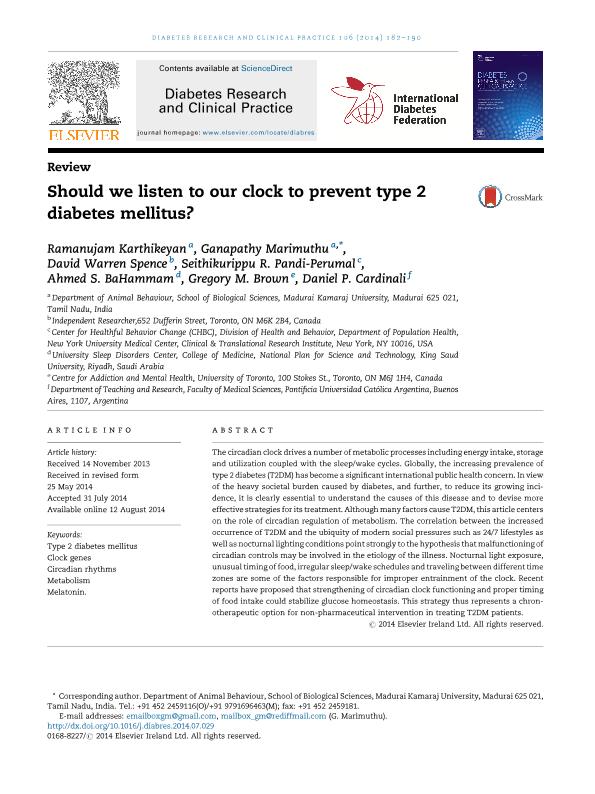Mostrar el registro sencillo del ítem
dc.contributor.author
Karthikeyan, Ramanujam
dc.contributor.author
Marimuthu, Ganapathy
dc.contributor.author
Spence, David Warren
dc.contributor.author
Pandi Perumal, Seithikurippu R.
dc.contributor.author
BaHammam, Ahmed S.
dc.contributor.author
Brown, Gregory M.
dc.contributor.author
Cardinali, Daniel Pedro

dc.date.available
2017-04-26T17:39:40Z
dc.date.issued
2014-11
dc.identifier.citation
Karthikeyan, Ramanujam; Marimuthu, Ganapathy; Spence, David Warren; Pandi Perumal, Seithikurippu R.; BaHammam, Ahmed S.; et al.; Should we listen to our clock to prevent type 2 diabetes mellitus?; Elsevier Ireland; Diabetes Research and Clinical Practice; 106; 2; 11-2014; 182-190
dc.identifier.issn
0168-8227
dc.identifier.uri
http://hdl.handle.net/11336/15740
dc.description.abstract
The circadian clock drives a number of metabolic processes including energy intake, storage and utilization coupled with the sleep/wake cycles. Globally, the increasing prevalence of type 2 diabetes (T2DM) has become a significant international public health concern. In view of the heavy societal burden caused by diabetes, and further, to reduce its growing incidence, it is clearly essential to understand the causes of this disease and to devise more effective strategies for its treatment. Although many factors cause T2DM, this article centers on the role of circadian regulation of metabolism. The correlation between the increased occurrence of T2DM and the ubiquity of modern social pressures such as 24/7 lifestyles as well as nocturnal lighting conditions point strongly to the hypothesis that malfunctioning of circadian controls may be involved in the etiology of the illness. Nocturnal light exposure, unusual timing of food, irregular sleep/wake schedules and traveling between different time zones are some of the factors responsible for improper entrainment of the clock. Recent reports have proposed that strengthening of circadian clock functioning and proper timing of food intake could stabilize glucose homeostasis. This strategy thus represents a chronotherapeutic option for non-pharmaceutical intervention in treating T2DM patients.
dc.format
application/pdf
dc.language.iso
eng
dc.publisher
Elsevier Ireland

dc.rights
info:eu-repo/semantics/openAccess
dc.rights.uri
https://creativecommons.org/licenses/by-nc-nd/2.5/ar/
dc.subject
Circadian Rhythms
dc.subject
Clock Genes
dc.subject
Melatonin
dc.subject
Metabolism
dc.subject
Type 2 Diabetes Mellitus
dc.subject.classification
Fisiología

dc.subject.classification
Medicina Básica

dc.subject.classification
CIENCIAS MÉDICAS Y DE LA SALUD

dc.title
Should we listen to our clock to prevent type 2 diabetes mellitus?
dc.type
info:eu-repo/semantics/article
dc.type
info:ar-repo/semantics/artículo
dc.type
info:eu-repo/semantics/publishedVersion
dc.date.updated
2017-04-26T14:13:22Z
dc.journal.volume
106
dc.journal.number
2
dc.journal.pagination
182-190
dc.journal.pais
Irlanda

dc.journal.ciudad
Shannon
dc.description.fil
Fil: Karthikeyan, Ramanujam. Madurai Kamaraj University. School of Biological Sciences. Department of Animal Behaviour; India
dc.description.fil
Fil: Marimuthu, Ganapathy. Madurai Kamaraj University. School of Biological Sciences. Department of Animal Behaviour; India
dc.description.fil
Fil: Spence, David Warren.
dc.description.fil
Fil: Pandi Perumal, Seithikurippu R.. University of New York; Estados Unidos
dc.description.fil
Fil: BaHammam, Ahmed S.. King Saud University; Arabia Saudita
dc.description.fil
Fil: Brown, Gregory M.. University of Toronto; Canadá
dc.description.fil
Fil: Cardinali, Daniel Pedro. Pontificia Universidad Católica Argentina "Santa María de los Buenos Aires". Facultad de Ciencias Médicas; Argentina. Consejo Nacional de Investigaciones Científicas y Técnicas; Argentina
dc.journal.title
Diabetes Research and Clinical Practice

dc.relation.alternativeid
info:eu-repo/semantics/altIdentifier/doi/http://dx.doi.org/10.1016/j.diabres.2014.07.029
dc.relation.alternativeid
info:eu-repo/semantics/altIdentifier/url/http://www.sciencedirect.com/science/article/pii/S0168822714003313
Archivos asociados
